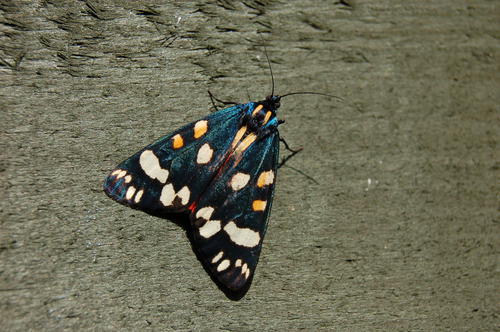Red devils and dancing tigers (Lily Beetles and Scarlet Tigers)
Mark Turner
Reading Harry’s request for records of Lily Beetle Lillioceris lillii my immediate reaction was OH DEAR! For at least the last ten years or so we have kept a close eye out for these very obvious insects since we always have a selection of pot plants on show. Needless to say an ongoing programme of eradication or ‘kill on sight’ policy is in place. The first week of June this year saw our first victim removed from a young Lily in a patio pot in our Evesham garden (SP044436), but a second adult insect did not appear until 20th July and in the same pot plant as the first one. Amazingly the Lilies appear unaffected by their alien visitors. A garden border clear-out on 8th August produced five adult Lily Beetles from three stems of flowering Lilies. The emergence continued unabated through August with one adult on 9th, two adults on 11th and two more on 17th. That makes five beetles from one patio pot and seven from three stems of garden border Lilies.
From the same Evesham garden a freshly emerged Scarlet Tiger Callimorpha dominula and an Angle Shades Phlogophora meticulosa first appeared on 30th May 2010. The Tigers are an annual local event here in the Bengeworth area from the end of May onwards, showing particularly well on sunny days. I had several sightings on 12th June and again a warm, bright, sunny afternoon of 16th June I had at least four individuals on the wing within a few minutes; and a new one drying its wings on a wooden fence.
Fine weather continued to assist more Tigers to emerge on 17th June, I saw three in the afternoon and come the evening a new moth had to be released from my garden shed. On 19th June we received a report that the Scarlet Tiger irruption had reached the Davis Road area of Evesham (roughly ¾km to the southeast of us).
23rd June had been another hot day (28ºC) and by evening the comfortable conditions seemed to trigger a notable emergence of Scarlet Tigers. I noticed the heightened activity between 20.00 and 21.00 hrs with no less than 23 garden overshoots (our garden is only 25 feet by 11 feet), but they were running the gauntlet of local Swifts and House Martins, enticing the birds to swoop low through neighbouring gardens. The garden overshoot tally for 26th June between 20.00 and 21.00 hrs increased markedly to 55. I recorded these moth fly-pasts if only to show the frequency of the to-ing and fro-ing along the row of terrace gardens. The Tigers’ flight pattern was becoming familiar to me; short deep undulations (dipping and rising), sometimes fast and erratic, even occasional spiralling manoeuvres. Only occasionally did two or three Tigers fly close together, generally all flights were solo efforts apparently males patrolling up and down a territory much like the manner of Dragonflies, but without any obvious purpose.
All this insect activity kept local birds busy including up to 36 Swifts in a feeding flock which drew in hunting Sparrowhawks, one of which caught a House Martin I noticed. Our neighbourhood male Blackbird interrupted his evensong to launch from a TV aerial at a Scarlet Tiger, but was unsuccessful. I wonder whether or not the moth’s striking colours and spots warned the Blackbird off.
The majority of Scarlet Tigers patrolling our row of gardens did so between 8-10 feet from ground level occasionally climbing up to house roof ridge height; some including ours being three storey buildings. Over time I saw many moths flutter and tumble over roof ridges and on the evening of 27th June Swifts were virtually taking our heads off in pursuit of their prey. However, I still hadn’t seen a single Tiger taken by a bird although it must have happened on numerous occasions one would assume. Even moths with worn wings fly strongly, determinedly, even tirelessly; they may not be the easiest of prey to catch.
A minimum of three occasionally four Scarlet Tigers patrolled our row of gardens on a regular basis and trees such as Eucalyptus, Cherry and Lilac seemed to draw the moths in close as if providing temporary cover from predators during their rounds.
At 21.30 hrs on 29th June my wife discovered a pair of Scarlet Tigers mating on our patio slabs thus providing us with a new observation. One remained in our garden until late morning the next day when it took flight in bright, glorious sunshine whilst its mate rested up in a patio pot.
Scarlet Tiger sightings dwindled as the new month of July got going and despite another perfect evening on 3rd July, I struggled to see what may have come down to the last patrolling moth on our block. He did but pass over me thrice. The Scarlet Tiger flight season was coming to an end and new insects began to appear in our 25x11 pocket handkerchief garden. Red Admiral Vanessa atalanta, Small Tortoiseshells Aglais urticae, and a female Common Hawker Aeshna juncea. The increasingly overgrown, weedy lane behind the garden produced a Small Magpie Moth Eurrhypara hortulata with its subtle but distinctive markings on a sunny morning of 5th July, but alas no Tigers.
